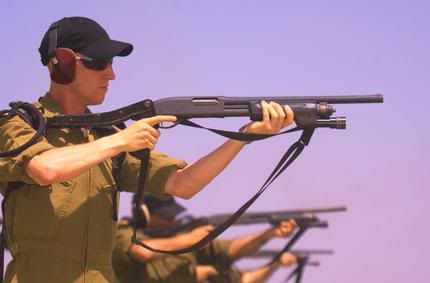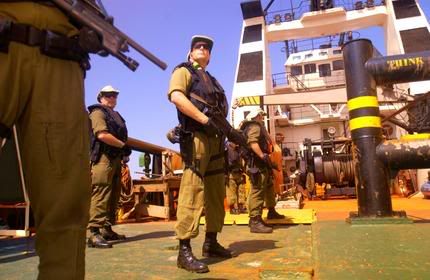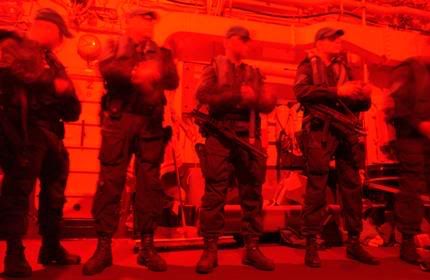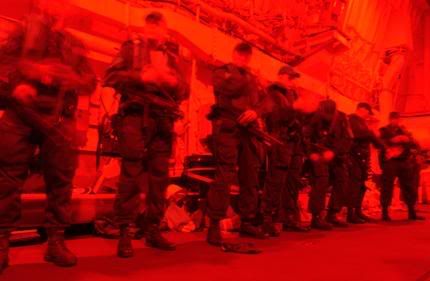Skip to comments.
Canadians join 'hot, dirty' offensive -- Coalition begins Operation Mountain Thrust
CanWest News Service via National Post ^
| 2006-06-15
| Matthew Fisher
Posted on 06/15/2006 4:14:51 AM PDT by Clive
PANJWAI, Afghanistan - Canadian troops will go on the attack today in the mountains north of Kandahar as part of Operation Mountain Thrust -- the largest coalition offensive against the Taliban since Afghanistan fell to U.S.-led forces in late 2001.
Addressing some of his 2,300 troops about the upcoming offensive, Lieutenant-Colonel Ian Hope, commander of the Canadian battle group, said his troops had done "extremely well so far," but that they had to "take the fight to [the Taliban] constantly.
"I know that it is hot. I know that it is dirty, but we've got to do it. I'll keep pushing you out there because that is the only way we will win."
About 4,000 combat troops from coalition forces and about 3,500 Afghan soldiers, as well as Afghan police, are to be deployed in the offensive. The operation is expected to last several weeks in rugged, remote country where the Taliban remains popular with many of the deeply conservative local population and which the Islamic radicals use to make safe passage from sanctuaries in neighbouring Pakistan.
It will focus on southern Uruzgan and northeastern Helmand, where the military says most of the insurgent forces have gathered. Operations will also be conducted in the former Taliban stronghold of Kandahar and Zabul.
"The purpose of the operation, very broadly, is to extend the reach of the government of Afghanistan into areas that up to now have been under Taliban influence and control," said Colonel Chris Vernon, a British officer working with Brigadier-General David Fraser, the Canadian who oversees coalition operations in the south of the country.
"The key will be to leave a permanent presence there," Col. Vernon said. "What we want to try to do is leave police stations and Afghan national army in the areas so they never again are under Taliban influence."
At least 500 Taliban have died, according to coalition estimates, since the beginning of last month when the insurgents launched a long-anticipated spring offensive.
Mountain Thrust takes advantage of a surge in allied troop numbers prior to the departure of several thousand U.S. soldiers from the 10th Mountain Division, who are being replaced by British, Dutch and Canadians troops. The Afghan mission will move to NATO, rather than U.S., control at the end of July.
Although thousands of coalition troops will be deployed across a huge area, and fighter jets, bombers and assault helicopters will be on call, major battles are unlikely because the nature of the Taliban insurgency is a series of often-bloody and relatively short skirmishes.
"We've actually been at it up there for three weeks now, but we are now entering a much broader phase of the operation," Lt.-Col. Hope said. "While Mountain Thrust is big, it doesn't raise the level of my battle group any higher. What it does is it brings in the Americans, the British and the Dutch to put pressure on the Taliban across all four southern provinces."
Two Canadians were seriously wounded this week in recent clashes in the Panjwai District. The two, members of Charlie Company, 1st Battalion, Princess Patricia's Canadian Light Infantry, were hit by rifle fire after they ran into a small concentration of Taliban fighters hiding in a bunker used to dry grapes.
"It was fairly intense from the get-go in there," said Major Bill Fletcher, who led the assault and was only a metre away from where his two soldiers were hit.
"After initial contact, we pinned them in place and were manoeuvring to complete their destruction when, in my opinion, they got lucky. One Taliban saw some movement and shot a burst through a narrow V in a wall. It hit our first two men."
The Canadian troops then laid down suppressing fire across the entire area while a U.S. Air Force A-10 jet was called in to drop a 1,000-pound bomb on the bunker.
Speaking of the wounded Canadians, whose names have not yet been released, Maj. Fletcher said, "Both guys are as tough as nails. One walked out with the help of another soldier while the other was cracking jokes."
The south saw a dramatic upsurge in insurgency-linked violence in mid-May, with Taliban fighters taking on Afghan and foreign troops in some of their biggest battles in years.
TOPICS: Canada; Foreign Affairs; War on Terror
KEYWORDS:
Navigation: use the links below to view more comments.
first previous 1-20, 21-33 last
To: Clive
Its difficult to get a picture of the men involved all round from here in the States, Thanks Clive for passing this info along to me.
Its good that they have a good press man along and if he understands the troops , he is more likely to survive his assignment.
21
posted on
06/15/2006 3:39:08 PM PDT
by
Candor7
((Into Liberal flatulance goes the best hope of the West, and who wants to be a smart feller?)
To: Clive
Canadians join 'hot, dirty' offensive.
I just realized that domestically this header looks like a dating initiative with femino-Canadian Nazis at the U of T!
LOL!
I thought it funny because such an initiative would likely be almost as dangerous as the road from Kandahar to Quetta!
22
posted on
06/15/2006 3:51:03 PM PDT
by
Candor7
((Into Liberal flatulance goes the best hope of the West, and who wants to be a smart feller?)
To: Candor7
Benelli Pump with mag extender, capable 3.5 inch 12 gauge ammo, 8 rounds and one chambreed in standard shells. Needs an ATI Tactical butt stock and heat shield...
23
posted on
06/15/2006 4:28:34 PM PDT
by
CaptainCanada
("Macht doch Eiern Dreck aleene!" (Take care of your own mess!).)
To: Candor7
To: NorthOf45
Thanks North!!! He appears to be a lad from my neck of the woods.Very interesting to see Nova Scotia people move into other Scots regiments across the country. His transfer from the West Novies to PPCLI indicates a desire for action posting.
May Hope stay the course!!
25
posted on
06/16/2006 1:42:36 AM PDT
by
Candor7
((Into Liberal flatulance goes the best hope of the West, and who wants to be a smart feller?)
To: CaptainCanada
Needs an ATI Tactical butt stock and heat shield...>>>>>>>>>>>>>>>>>>>>>>>
The semi auto military version has a pistol grip stock, no heat sheild though. The US Marines use the semi auto and the Nova pump. The barrel can be changed out in less than a minute.With the Nova pump you can press a button and pump out the mag without chambering any shells, which saves time!
With the tactical Nova, the barrel is unmodified, and you can group rifled slugs at a 100 yards!
There are a lot of good pumps on the market,and Benelli is among the best of them.
26
posted on
06/16/2006 6:20:10 AM PDT
by
Candor7
((Into Liberal flatulance goes the best hope of the West, and who wants to be a smart feller?)
To: Candor7
To: recce guy
Good to know on the Remington SGs, They have been life savers in forced entry and house clearing tasks by US Marines.
BTW, if you are interested , there is a lot of 12 gauge exotic ammo, such as flechettes and plastic lock buster rounds on the market.
My Benelli Nova Tactical has an unmodified barrel ( no choke) and its the first SG I have owned that can accurately group rifled slugs at 100 yards, 8 to 10 inches. Some of the batch on my guns production run are in Iraq now,(The secret is to also have a really clean barrel as well.)On double ought buck, the gun spreads the shot to a diameter of about 3 feet over 25 yards. I can clear 8 rounds in about 10 seconds with fair accuracy. The shoulder is another matter entirely.(Ouch!)
The tactical semi-auto Benelli is in such demand by US troops that the entire production run was sequestered by US forces last year. It is really hard to get one even now.
28
posted on
06/18/2006 10:50:31 PM PDT
by
Candor7
(Into Liberal flatulance goes the best hope of the West, and who wants to be a smart feller?)
To: Candor7
I would love to personally own a Benelli but can't really afford it. We have the lock buster rounds in the Cdn Forces system but have not seen any flechette rounds. Those sound like they could hurt.
To: recce guy
http://www.antipersonnel.net/sdllc/007.html
Some who redeploy to Iraq take some of these with them for special occasions.
30
posted on
06/19/2006 10:45:02 AM PDT
by
Candor7
(Into Liberal flatulance goes the best hope of the West, and who wants to be a smart feller?)
To: Candor7
COMBAT COMPARISON
During the United States Vietnam War of 1965-1972 shotguns played an active role with ground forces and buckshot and flechette ammunition were actively evaluated for combat effectiveness. Combat evaluations from May 1967 to February 1968 were made with flechettes, M162 00 buckshot, and XM257 #4 buckshot. Flechette ammunition indicated a high lethality at all ranges with several one shot kills at engagement ranges to 100 yards, flechettes were prefered by combatants equally to 00 buckshot during this test phase. Flechette ammunition and 00 buckshot were also equally prefered over the issued XM257 #4 buckshot, which proved ineffective under combat conditions, lacking the penitration and terminal performance of either flechettes or 00 buckshot. Adoption of a standardized flechette cartridge was hindered by the United States govenment decision to begin disengaging from the Vietnam War. Flechette superiority to buckshot has proven manifest for all aspects of performance in velocity, grouping, and terminal effects.
31
posted on
06/19/2006 10:47:23 AM PDT
by
Candor7
(Into Liberal flatulance goes the best hope of the West, and who wants to be a smart feller?)
To: recce guy; Candor7
Ah yes, the Remingotn 870, one of our boarding parties' favourites. From
Combat Camera ...

April 7, 2003, HMCS Iroquois, Gulf of Oman, Arabian Gulf Region (
Hi Res ) - A member of the naval boarding party fires the Remington 870 combat shotgun during rangework aboard HMCS Iroquois in the Gulf of Oman. HMCS Iroquois is the flagship for coalition Task Force 151 which is responsible for escorting ships, intercepting and boarding suspect vessels and guarding against attacks on shipping, in support of Operation Apollo, Canada's contribution to the international campaign against terrorism.

April 6, 2003, HMCS Regina, Gulf of Oman, Arabian Gulf Region (
Hi Res ) - Members of HMCS Regina's naval boarding party, armed with MP5 sub machine guns
(and Remington 870 SGs), stand guard on the aft deck during a boarding of a suspect vessel in the Gulf of Oman. The Canadian frigate is part of Coalition Task Force 151, and is responsible for escorting ships, intercepting and boarding suspect vessels and guarding against attacks on shipping, in support of Operation Apollo.

April 5, 2003, HMCS Regina, Gulf of Oman, Arabian Gulf Region (
Hi Res ) - Members of HMCS Regina's naval boarding party receive orders under red light conditions in the ships hangar, prior to a night boarding of a suspect vessel in the Gulf of Oman. Red light is used in order to preserve the night vision before the mission, and the boarding party is well-armed with a variety of weapons including shotguns, assault rifles, machine guns, and pistols. The Canadian frigate is part of Coalition Task Force 151.

April 5, 2003, HMCS Regina, Gulf of Oman, Arabian Gulf Region (
Hi Res ) - Members of HMCS Regina's naval boarding party receive orders under red light conditions in the ships hangar, prior to a night boarding of a suspect vessel in the Gulf of Oman. Red light is used in order to preserve the night vision of the boarding party before the mission. The Canadian frigate is part of Coalition Task Force 151.
To: NorthOf45
Wow North! Thanks for the great pic links, being a shot gun fan myself, I appreciate these photos a lot
33
posted on
06/22/2006 9:20:07 PM PDT
by
Candor7
(Into Liberal flatulance goes the best hope of the West, and who wants to be a smart feller?)
Navigation: use the links below to view more comments.
first previous 1-20, 21-33 last
Disclaimer:
Opinions posted on Free Republic are those of the individual
posters and do not necessarily represent the opinion of Free Republic or its
management. All materials posted herein are protected by copyright law and the
exemption for fair use of copyrighted works.
FreeRepublic.com is powered by software copyright 2000-2008 John Robinson



